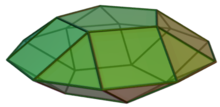Pentagonal gyrobicupola
| Pentagonal gyrobicupola | |
|---|---|
 | |
| Type | Bicupola, Johnson J30 – J31 – J32 |
| Faces | 10 triangles 10 squares 2 pentagons |
| Edges | 40 |
| Vertices | 20 |
| Vertex configuration | |
| Symmetry group | |
| Properties | convex, composite |
| Net | |
 | |
The pentagonal gyrobicupola is a polyhedron that is constructed by attaching two pentagonal cupolas base-to-base, each of its cupolas is twisted at 36°. It is an example of a Johnson solid and a composite polyhedron.
Construction
The pentagonal gyrobicupola is a composite polyhedron: it is constructed by attaching two pentagonal rotundas base-to-base. This construction is similar to the pentagonal orthobicupola; the difference is that one of cupolas in the pentagonal gyrobicupola is twisted at 36°, as suggested by the prefix gyro-. The resulting polyhedron has the same faces as the pentagonal orthobicupola does: those cupolas cover their decagonal bases, replacing it with eight equilateral triangles, eight squares, and two regular pentagons.[1] A convex polyhedron in which all of its faces are regular polygons is the Johnson solid. The pentagonal gyrobicupola has such these, enumerating it as the thirty-first Johnson solid .[2]
Properties
Because it has a similar construction as the pentagonal orthobicupola, the surface area of a pentagonal gyrobicupola is the sum of polygonal faces' area, and its volume is twice the volume of a pentagonal cupola for which slicing it into those:[1]
References
- ^ a b Berman, Martin (1971). "Regular-faced convex polyhedra". Journal of the Franklin Institute. 291 (5): 329–352. doi:10.1016/0016-0032(71)90071-8. MR 0290245.
- ^ Francis, Darryl (August 2013). "Johnson solids & their acronyms". Word Ways. 46 (3): 177.
External links
- Weisstein, Eric W., "Pentagonal gyrobicupola" ("Johnson solid") at MathWorld.
- v
- t
- e
- elongated triangular pyramid
- elongated square pyramid
- elongated pentagonal pyramid
- gyroelongated square pyramid
- gyroelongated pentagonal pyramid
- triangular bipyramid
- pentagonal bipyramid
- elongated triangular bipyramid
- elongated square bipyramid
- elongated pentagonal bipyramid
- gyroelongated square bipyramid
- elongated triangular cupola
- elongated square cupola
- elongated pentagonal cupola
- elongated pentagonal rotunda
- gyroelongated triangular cupola
- gyroelongated square cupola
- gyroelongated pentagonal cupola
- gyroelongated pentagonal rotunda
- gyrobifastigium
- triangular orthobicupola
- square orthobicupola
- square gyrobicupola
- pentagonal orthobicupola
- pentagonal gyrobicupola
- pentagonal orthocupolarotunda
- pentagonal gyrocupolarotunda
- pentagonal orthobirotunda
- elongated triangular orthobicupola
- elongated triangular gyrobicupola
- elongated square gyrobicupola
- elongated pentagonal orthobicupola
- elongated pentagonal gyrobicupola
- elongated pentagonal orthocupolarotunda
- elongated pentagonal gyrocupolarotunda
- elongated pentagonal orthobirotunda
- elongated pentagonal gyrobirotunda
- gyroelongated triangular bicupola
- gyroelongated square bicupola
- gyroelongated pentagonal bicupola
- gyroelongated pentagonal cupolarotunda
- gyroelongated pentagonal birotunda
- augmented truncated tetrahedron
- augmented truncated cube
- biaugmented truncated cube
- augmented truncated dodecahedron
- parabiaugmented truncated dodecahedron
- metabiaugmented truncated dodecahedron
- triaugmented truncated dodecahedron
- gyrate rhombicosidodecahedron
- parabigyrate rhombicosidodecahedron
- metabigyrate rhombicosidodecahedron
- trigyrate rhombicosidodecahedron
- diminished rhombicosidodecahedron
- paragyrate diminished rhombicosidodecahedron
- metagyrate diminished rhombicosidodecahedron
- bigyrate diminished rhombicosidodecahedron
- parabidiminished rhombicosidodecahedron
- metabidiminished rhombicosidodecahedron
- gyrate bidiminished rhombicosidodecahedron
- tridiminished rhombicosidodecahedron

















